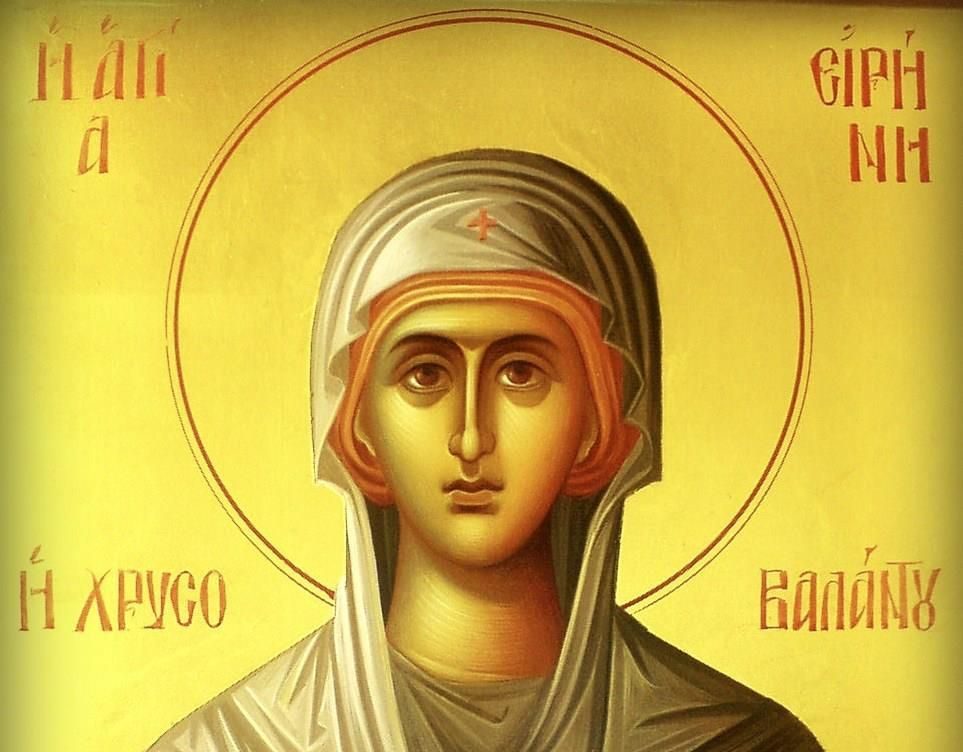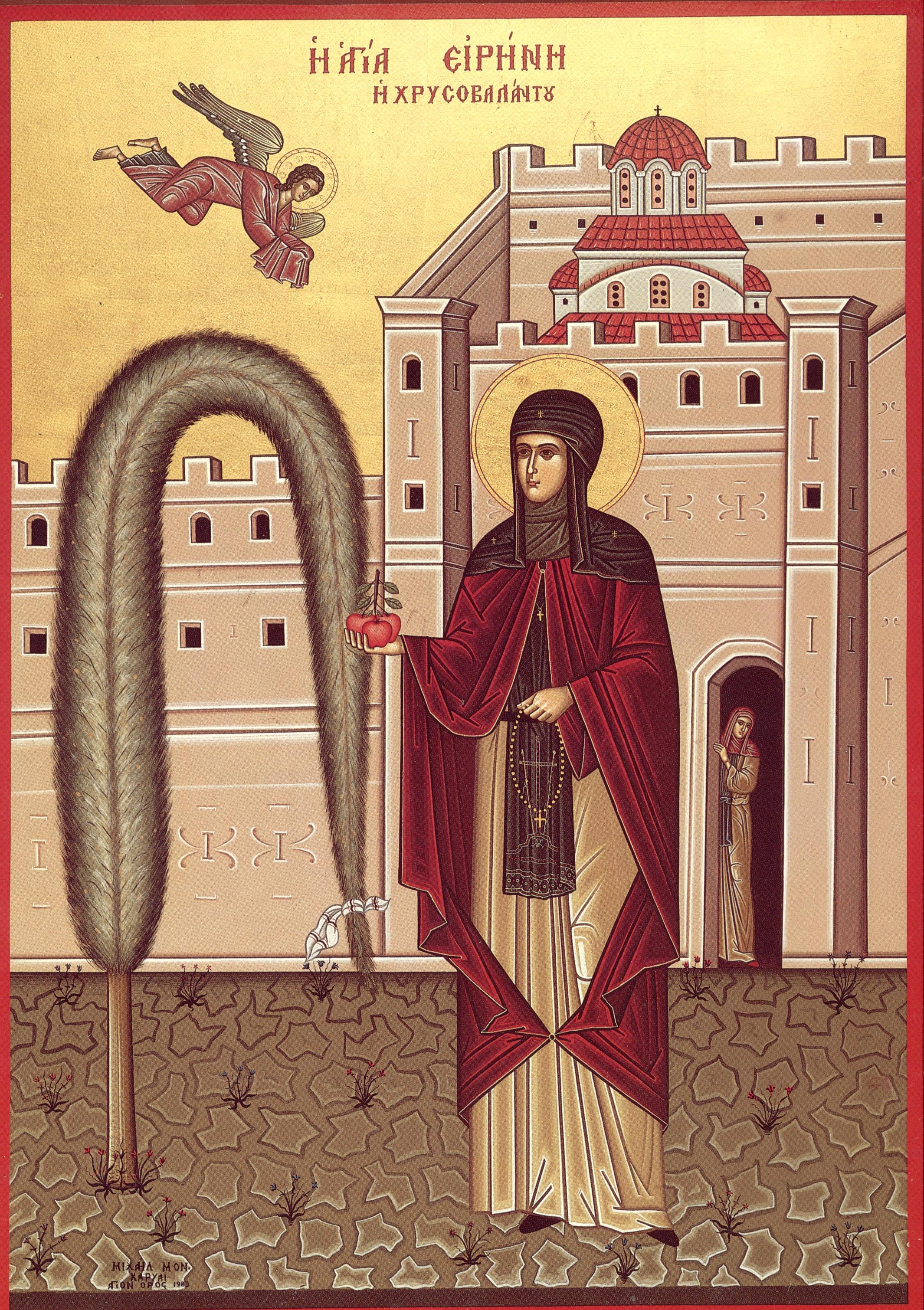Saint Irene the Righteous of Chrysovalantou (28 July)

Saint Irene was the daughter of a wealthy family from Cappadocia, and was born in the ninth century.
After the death of her husband Theophilus, the empress Theodora ruled the Byzantine Empire as regent for her young son Michael. Saint Theodora (February 11) helped to defeat the iconoclast heresy, and to restore the holy icons. We commemorate this Triumph of Orthodoxy on the first Sunday of Great Lent.
When Michael was twelve years of age, Saint Theodora sent messengers throughout the Empire to find a suitably virtuous and refined girl to be his wife. Saint Irene was chosen, and she agreed to the marriage. While passing Mt. Olympus in Asia Minor, Irene asked to stop so she could receive the blessing of Saint Joannicius (November 4), who lived on the mountain. The saint, who showed himself only to the most worthy pilgrims, foresaw the arrival of Saint Irene, and also her future life.
The holy ascetic welcomed her and told her to proceed to Constantinople, where the women’s monastery of Chrysovalantou had need of her. Amazed at his clairvoyance, Irene fell to the ground and asked Saint Joannicius for his blessing. After blessing her and giving her spiritual counsel, he sent her on her way.
When the party arrived in Constantinople, Irene’s relatives met her with great ceremony. Since “the steps of a man are rightly ordered by the Lord” (Ps. 36/37:23), God arranged for Michael to marry another girl a few days before, so that Irene might be free to become a bride of Christ. Far from being disappointed, Irene rejoiced at this turn of events.
Remembering the words of Saint Joannicius, Irene visited the Monastery of Chrysovalantou. She was so impressed by the nuns and their way of life that she freed her slaves and distributed her wealth to the poor. She exchanged her fine clothing for the simple garb of a nun, and served the sisters with great humility and obedience. The abbess was impressed with the way that Irene performed the most menial and disagreeable tasks without complaint.
Saint Irene often read the Lives of the Saints in her cell, imitating their virtues to the best of her ability. She often stood in prayer all night with her hands raised like Moses on Mt. Sinai (Exodus 17:11-13). Saint Irene spent the next few years in spiritual struggles defeating the assaults of the demons, and bringing forth the fruits of the Holy Spirit (Galatians 5:22-23).
When the abbess sensed the approach of death, she told the other nuns that they should not accept anyone but Irene as the new abbess. Irene was not told of the abbess’s instructions, and when she died the community sent representatives to go and seek the advice of the patriarch, Saint Methodius (June 14). He asked them whom they wanted as their superior. They replied that they believed he would be guided by the Holy Spirit. Without knowing of the late abbess’s instructions to the nuns, he asked if there was a humble nun by the name of Irene in their monastery. If so, he said, they should choose her. The nuns rejoiced and gave thanks to God. Saint Methodius elevated Irene to the rank of abbess and advised her how to guide those in her charge.
Returning to the monastery, Irene prayed that God would help her to care for those under her, and redoubled her own spiritual efforts. She displayed great wisdom in leading the nuns, and received many revelations from God to assist her in carrying out her duties. She also asked for the gift of clairvoyance so that she would know what trials awaited her nuns. Thus, she was in a better position to give them the proper advice. She never used this knowledge to embarrass others, but only to correct their confessions in a way which let them know that she possessed certain spiritual gifts.

Although Saint Irene performed many miracles during her life, let us mention only one. On great Feasts it was her habit to keep vigil in the monastery courtyard under the starry skies. Once, a nun who was unable to sleep left her cell and went into the courtyard. There she saw Abbess Irene levitating a few feet above the ground, completely absorbed in prayer. The astonished nun also noticed that two cypress trees had bowed their heads to the ground, as if in homage. When she finished praying, Irene blessed the trees and they returned to their upright position.
Afraid that this might be a temptation from the demons, the nun returned the next night to see if she had been mistaken. Again she saw Irene levitating as she prayed, and the cypress trees bowing down. The nun tied handkerchiefs to the tops of the two trees before they went back to their places. When the other sisters saw the handkerchiefs atop the trees, they began to wonder who had put them there. Then the nun who had witnessed these strange events revealed to the others what she had seen. When Saint Irene learned that the nun had witnessed the miracle and told the others, she was very upset. She warned them not to speak of it to anyone until after her death.
Saint Irene observed the Feast of Saint Basil (January 1) with great devotion, since he also came from Cappadocia. One year, after celebrating the feast, Saint Irene heard a voice during the night telling her to welcome the sailor who would come to the door the next day. She was told to rejoice and eat the fruit which the sailor would bring her. During Matins, a sailor did come to the door and remained in church until after Liturgy. He told her that he had come from Patmos, where he boarded a ship. As the ship set sail, he noticed an old man on the shore calling for them to stop. In spite of a good wind, the ship came to a sudden halt. Then the old man walked across the water and entered the ship. He gave the sailor three apples which God was sending to the patriarch “from His beloved disciple John.” Then the old man gave the sailor three more apples for the abbess of Chrysovalantou. He told the sailor that if Irene ate the apples, all that her soul desired would be granted, “for this gift comes from John in Paradise.”
Saint Irene fasted for a week, giving thanks to God for this wonderful gift. For forty days, she ate small pieces of the first apple every day. During this time she had nothing else to eat or drink. On Holy Thursday, she told the nuns to receive the Holy Mysteries, then gave each one a piece of the second apple. They noticed an unusual sweetness, and felt as if their very souls were being nourished.
An angel informed Saint Irene that she would be called to the Lord on the day after Saint Panteleimon’s feast. The monastery’s feast day fell on July 26, so Saint Irene prepared by fasting for a week beforehand. She took only a little water and small pieces of the third apple sent to her by Saint John. The whole monastery was filled with a heavenly fragrance, and all discord disappeared.
On July 28, Saint Irene called the nuns together in order to bid them farewell. She also told them to select Sister Mary as her successor, for she would keep them on the narrow way which leads to life (Matthew 7:14). After entreating God to protect her flock from the power of the devil, she smiled when she saw the angels who had been sent to receive her soul. Then she closed her eyes and surrendered her soul to God.
Saint Irene was more than 101 years old when she died, yet her face appeared young and beautiful. A great crowd of people came for her funeral, and many miracles took place at her tomb.
In some parishes it is customary to bless apples on the feast of Saint Irene Chrysovalantou.

Saint Irene, who was from Cappadocia, flourished in the ninth century. Because of her great beauty and virtue, she was brought to Constantinople as a prospective bride for the young Emperor Michael (842-867); however, as Saint Joannicius the Great foretold, it was God’s will that she assume the monastic habit instead. She shone forth in great ascetical labours, and suffered many attacks from the demons; while yet a novice, she attained to the practice of Saint Arsenius the Great, of praying the whole night long with arms stretched out towards Heaven (see May 8). God showed forth great signs and wonders in her, and she became the Abbess of the Convent of Chrysovalantou.
She was granted the gift of clairvoyance and knew the thoughts of all that came to her. She appeared in a vision to the king and rebuked him for unjustly imprisoning a nobleman who had been falsely accused. Through a sailor from Patmos to whom he had appeared, Saint John the Evangelist sent her fragrant and wondrous apples from Paradise. She reposed at the age of 103, still retaining the youthful beauty of her countenance. After her repose, marvelous healings beyond number have been wrought by her to the present day.
Apolytikion of Irene Chrysovalantou
Plagal of the First Tone
Not a temporal kingdom on earth didst thou obtain, but Christ, thy most comely Bridegroom, vouchsafed thee heavenly crowns, and thou reignest as a queen with Him eternally; for thou didst dedicate thyself unto Him with all thy soul, O Irene, our righteous Mother, thou boast of Chrysovalantou, and mighty help of all the Orthodox.
Kontakion of Irene Chrysovalantou
Third Tone
Leaving all the world behind with its impermanent glory, thou wast wedded unto Christ, the King immortal and holy, bringing Him as precious dowry thy maiden beauty and thy trophies won through abstinence over demons. O Irene, our righteous Mother, entreat thy Bridegroom to show His mercy to us.
Source: oca.org / goarch.org





